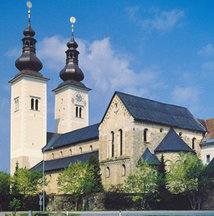Border: Austria-Slovenia
Date(s) of establishment: 1919 (Treaty of Saint-Germain-en-Laye); Current demarcation in 1991 (independence of Slovenia)Length of border: 330 km
Regions concerned: Austria – Provinces of Kärnten (Carinthia), Steiermark (Styria), Burgenland;
Slovenia – Statistical regions of Gorenjska (Upper Carniola), Koroška (Slovenian Carinthia), Savinjska (Savinja), Podravska (Drava), Pomurska (Mura)
European programme(s):
- Interreg IVA "Slovenia-Austria":
Website of the programme
The programme on the Inforegio website
The border between Austria and Slovenia is 330 km long and separates the countries from east to west, lying mostly in the Alps. It begins at the tripoint formed by the Austrian, Slovenian and Italian borders at the summit of the Ofen mountain at 1500 metres above sea level. In the east, the border comes to an end with the tripoint marking the crossing of the Austrian, Hungarian and Slovenian borders. This tripoint has the peculiarity of being accessible by a binational path. The border between the two countries runs along the middle.
History
This border came into existence in 1919 with the Treaty of Saint-Germain-en-Laye. Before this, the Slovenian territory was part of the Austro-Hungarian Empire and there was therefore no border. The end of the First World War confirms the inclusion of Slovenian territories in the first Yugoslavia, thus creating the border. The cross-border region of Carinthia is consequently split in two, one portion being attached to Austria and the other to Slovenia.
From 1938 to 1945, following the annexation of Austria by Germany, this demarcation became the border between Germany and Yugoslavia. During this period, Germany also occupied certain border areas in northern Slovenia, putting an end to the border. At the end of the Second World War, this border became part of the Iron Curtain and was therefore closely monitored.
In 1991, Slovenia declared its independence with regard to Yugoslavia. Austria quickly recognised Slovenian independence and the Austro-Slovenian border demarcation was thus definitively established in 1991. In 2004 Slovenia joined the European Union, before joining the Schengen Area in 2007, giving a new momentum to cooperation between the two regions.
Cross-border cooperation
The cross-border region of Carinthia symbolises the development of cooperation between these two countries. In certain towns on the Austrian side, nearly 25% of the population speaks Slovenian. This has pushed the government to install bilingual signage in many municipalities in southern Carinthia.
Currently, cross-border cooperation between the two countries aims to ensure the economic competitiveness of the area, while taking into account the different levels of development on either side of the border. Nevertheless, Slovenia’s entry into the European Union offers considerable opportunities for the development of cross-border cooperation. For instance, the opening up of the Austrian labour market to the Slovenians is one such opportunity. The Alps-Adriatic Working Community has been working towards this goal since its creation in 1978.
As a large tourist destination, the region of Carinthia is likely to improve its offering by promoting a unique cross-border regional and cultural identity. Development of the region also involves protection of the environment and the preservation of its rich natural and cultural heritage.
The existing Slovenian transport infrastructure highlights the fact that the border region should be seen as a space of crossings and exchanges between the Danube basin, Vienna and the Po Plain.
Photo : Alps Adriatic Working Community


